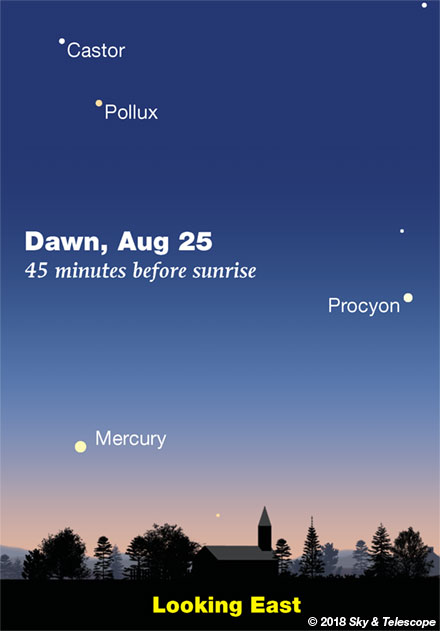
Friday, August 24
• For yet another week, four bright planets await your view at once as twilight fades. From right to left, they are Venus very low in the west-southwest, Jupiter in the southwest (upper left of Venus), Saturn in the south a little higher than Jupiter, and bright Mars lower in the south-southeast. Best view: about 40 minutes after sunset. Here's a wide-field image August 17th over the skyline of Rome, courtesy Gianluca Masi.
Saturday, August 25
• Full Moon tonight and tomorrow (it's exactly full at 7:56 a.m. on the 26th Eastern Daylight Time, splitting the difference for evening viewers in the Americas). This evening, the Moon shines in Capricornus far left of Mars.
Sunday, August 26
• A winter preview: Step out before the first light of dawn this week, and the sky displays the same starry panorama as it does after dinnertime in late January and early February. Orion is standing up in the southeast, with Aldebaran and then the Pleiades high above him. Sirius sparkles far below Orion. The Gemini twins are lying on their sides left of Orion, well up in the east.
Monday, August 27
• Mars shines fire-color in the south-southeast after dark. High above it, by three or four fists at arm's length, shines white Altair.
And a finger width above Altair is fainter Tarazed, an orange giant that's actually more luminous than Altair but far in the background. The two are 17 and 390 light-years away.
Tuesday, August 28
• After nightfall this week, Arcturus and the Big Dipper shine equally high in the west and northwest, respectively.
Wednesday, August 29
• Summer's end approaches. Soon after dark now, Cassiopeia has risen as high in the northeast as the Big Dipper has sunk down to in the northwest. Find Polaris a little above the midpoint between them.
Thursday, August 30
• Now that the waning Moon doesn't rise until nearly an hour after dark, you have a window of darkness to explore the telescopic double stars and open clusters in high Lacerta, the Lizard, using Sue French's Deep-Sky Wonders column, charts and photos in the September Sky & Telescope, page 55. Do you know why the 17th-century creator of Lacerta also named it Stellio? Hint: not real stars.*
Friday, August 31
• Look for bright Vega passing the zenith as twilight fades out, if you live in the world's mid-northern latitudes. Vega goes right through your zenith if you're at latitude 39° north (near Baltimore, Kansas City, Lake Tahoe, Sendai, Beijing, Athens, Lisbon).
Then Deneb follows two hours behind. For Deneb to pass exactly through your zenith you need to be a little farther north, at latitude 45°: near Bangor, Montreal, Minneapolis, mid-Oregon, northernmost Japan, Bucharest, Milan.
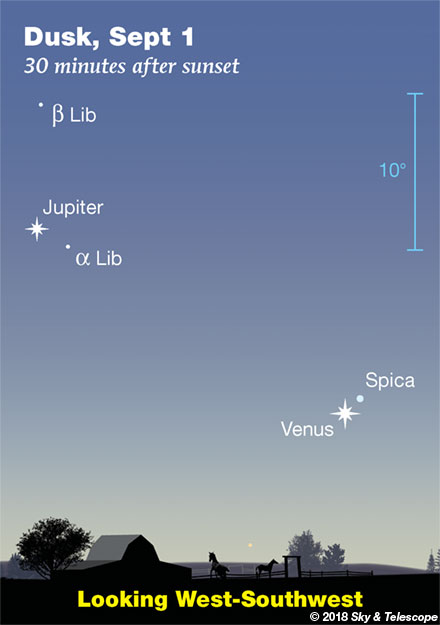
Saturday, September 1
• As twilight fades this evening, spot Venus very low in the west-southwest as shown here. Upper right of it by just 1.3° is Spica, a 1st-magnitude star but less than 1% as bright as Venus. Can you see Spica naked-eye through the twilight? They're about a finger-width at arm's length apart. Or, try binoculars.
• After dark as August turns to September, the Great Square of Pegasus looms up in the east, balancing on one corner. Its stars are only 2nd and 3rd magnitude. Extending leftward from the Square's left corner is the main line of the constellation Andromeda. It's made of three stars (including the corner) that are about as bright as the others forming the Square.
This whole giant pattern was named "the Andromegasus Dipper" by the late Sky & Telescope columnist George Lovi. Shaped sort of like a giant Little Dipper with an extra-big bowl, it's currently lifting its contents upward.
The actual Little Dipper, meanwhile, has tipped over leftward in the north. It's only 40% as long as the Andromegasus Dipper, and most of it is much fainter. You'll always find the Little Dipper oriented more than 90° counterclockwise compared to Andromegasus.
________________________
Want to become a better astronomer? Learn your way around the constellations! They're the key to locating everything fainter and deeper to hunt with binoculars or a telescope.
This is an outdoor nature hobby. For an easy-to-use constellation guide covering the whole evening sky, use the big monthly map in the center of each issue of Sky & Telescope, the essential guide to astronomy.

Once you get a telescope, to put it to good use you'll need a detailed, large-scale sky atlas (set of charts). The basic standard is the Pocket Sky Atlas (in either the original or Jumbo Edition), which shows stars to magnitude 7.6.
Next up is the larger and deeper Sky Atlas 2000.0, plotting stars to magnitude 8.5; nearly three times as many. The next up, once you know your way around, are the even larger Interstellarum atlas (stars to magnitude 9.5) and Uranometria 2000.0 (stars to magnitude 9.75). And read how to use sky charts with a telescope.
You'll also want a good deep-sky guidebook, such as Sue French's Deep-Sky Wonders collection (which includes its own charts), Sky Atlas 2000.0 Companion by Strong and Sinnott, or the bigger Night Sky Observer's Guide by Kepple and Sanner.
Can a computerized telescope replace charts? Not for beginners, I don't think, and not on mounts and tripods that are less than top-quality mechanically (meaning heavy and expensive). And as Terence Dickinson and Alan Dyer say in their Backyard Astronomer's Guide, "A full appreciation of the universe cannot come without developing the skills to find things in the sky and understanding how the sky works. This knowledge comes only by spending time under the stars with star maps in hand."
This Week's Planet Roundup
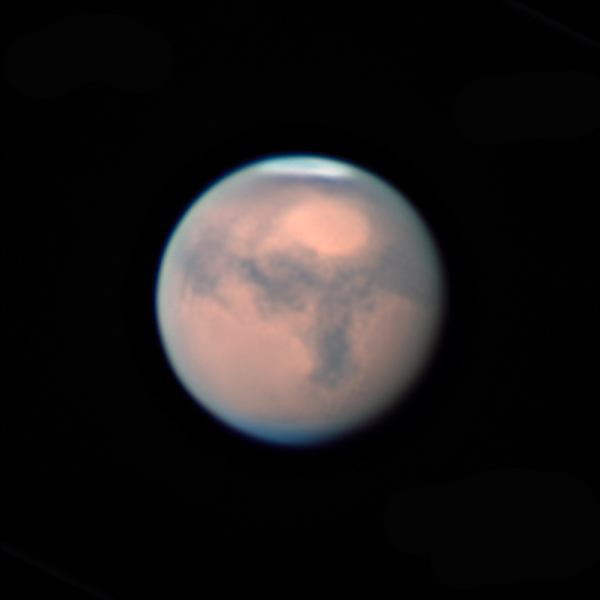
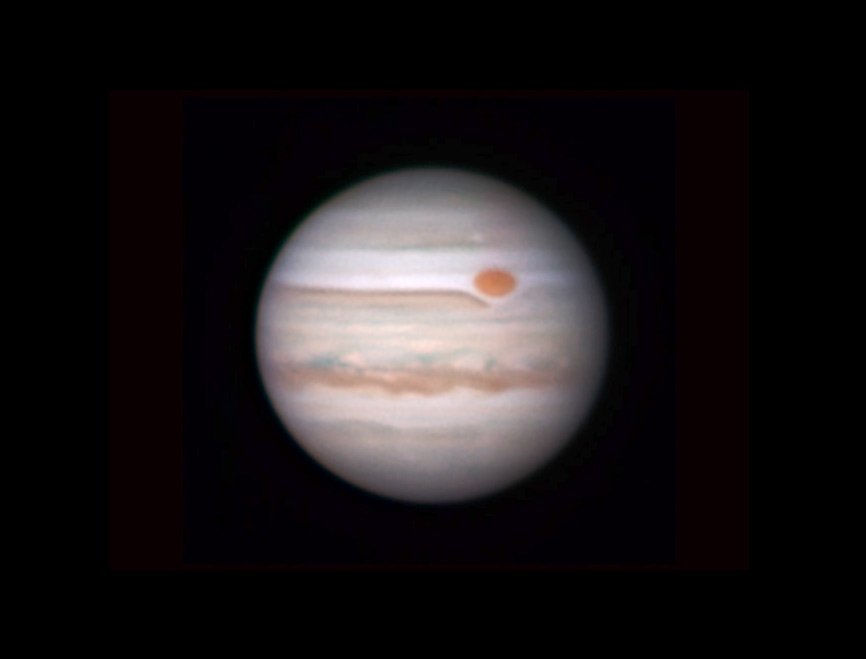
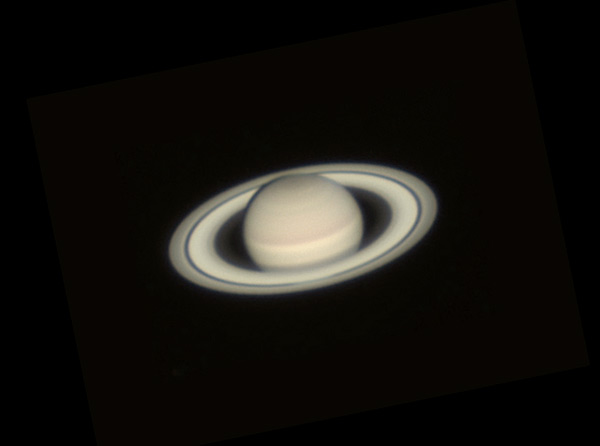
Mercury is having a fairly good morning apparition. Look for it very low above the east-northeast horizon about 45 minutes before sunrise, as shown at the top of this page. This week Mercury roughly doubles in brightness, from magnitude +0.1 on the morning of August 25th to –0.7 on the 31st.
Don't confuse Mercury with twinkly Procyon off to its upper right.
Venus (magnitude –4.6) shines low in the west-southwest in twilight. In a telescope Venus is a very fat crescent 28 arcseconds tall. For the best telescopic seeing catch Venus as early as you can, preferably long before sunset while it is still high.
Mars fades from magnitude –2.3 to –2.1 this week. On the other hand, it rises higher in the southeast earlier in the evening and stands highest in the south around 10 or 11 p.m. daylight-saving time. (Although it's not very high for us mid-northern observers; it's at declination –26°, at the border of Capricornus and Sagittarius). Mars shrinks from 22 to 21 arcseconds wide this week, still very unusually large.
The dust in its atmosphere continues to thin. For a Mars map that shows which side is facing Earth at your time and date, use our Mars Profiler.
Jupiter (magnitude –2.0, in Libra) shines in the southwest in twilight. It's about 25° upper left of low Venus. Find Mars-colored Antares a similar distance to Jupiter's left.
Saturn (magnitude +0.4, above the spout-tip of the Sagittarius Teapot) glows yellow in the south at nightfall. Saturn is about 23° left of Antares, and about 27° right or upper right of Mars.
Uranus (magnitude 5.8 at the Aries-Pisces border) and Neptune (magnitude 7.8 in Aquarius) are well up in the east and southeast, respectively, by midnight. Finder charts for Uranus and Neptune.
______________________
All descriptions that relate to your horizon — including the words up, down, right, and left — are written for the world's mid-northern latitudes. Descriptions that also depend on longitude (mainly Moon positions) are for North America.
Eastern Daylight Time (EDT) is Universal Time (also called UT, UTC, GMT, or Z time) minus 4 hours.
______________________
"Remember to look up at the stars and not down at your feet. Try to make sense of what you see and wonder about what makes the universe exist. Be curious."
— Stephen Hawking, 1942–2018
______________________
"The dangers of not thinking clearly are much greater now than ever before. It's not that there's something new in our way of thinking, it's that credulous and confused thinking can be much more lethal in ways it was never before."
— Carl Sagan, 1996
______________________
"Objective reality exists. Facts are often determinable. Vaccines save lives. Carbon dioxide warms the globe. Bacteria evolve to thwart antibiotics, because evolution. Science and reason are not a liberal conspiracy. They are how we determine facts. Civilization's survival depends on our ability, and willingness, to do this."
— Alan MacRobert, your Sky at a Glance editor
______________________
"Facts are stubborn things."
— John Adams, 1770
* Okay, about Stellio: In the 17th century When Johannes Hevelius named this group Lacerta sive Stellio (Lacerta or Stellio), the species of lizard he had in mind was the stellion, which lives around the shores of the Mediterranean and is dotted with little spots like stars.
 3
3








Comments
Trekkieal
August 25, 2018 at 9:42 am
Sean Walker's images are stunning...do we know the details on his telescopic & photo equipment?
You must be logged in to post a comment.
Sean Walker
August 27, 2018 at 9:24 am
Thank you- I image the planets with a 12.5-inch f/5.1 Newtonian reflector, 4x Tele Vue Powermate, and ZWO ASI120MM video camera through Astrodon RGB filters from my home in Litchfield, NH. Good seeing this year is rare, given the low altitude of the bright planets as seen from my location at +42.9 Lat.
You must be logged in to post a comment.
Rod
August 28, 2018 at 7:53 am
Trekkieal, Sean et al. On 23-Aug-18, I enjoyed some very good views of Mars and Saturn using my XT10i telescope. I used Orion Sirius 10-mm plossl with an older, TeleVue 1.8x barlow lens for about 216x views. The images of the planets in this report are very good. I use a 90-mm refractor for many views that has 1.25 inch focuser. From my stargazing log:
"Observed 2100-2200 EDT. USNO sunset at 1951 EDT. Moon transit at 2328 EDT, waxing gibbous Moon 93% illuminated in Capricornus near 2200 position of Mars about 10 degrees or less NE of Mars. Very bright waxing gibbous Moon, Full Moon 26-Aug-18 at 0756 EDT. Great views of Mars tonight using the XT10i with Orion Sirius 10-mm plossl and TeleVue 1.8x barlow lens for 216x view and 0.24 degree true field of view. Mars was much brighter in the XT10i view than the 90-mm at 180x. Much more surface detail visible and color was yellow-orange."
You must be logged in to post a comment.
You must be logged in to post a comment.